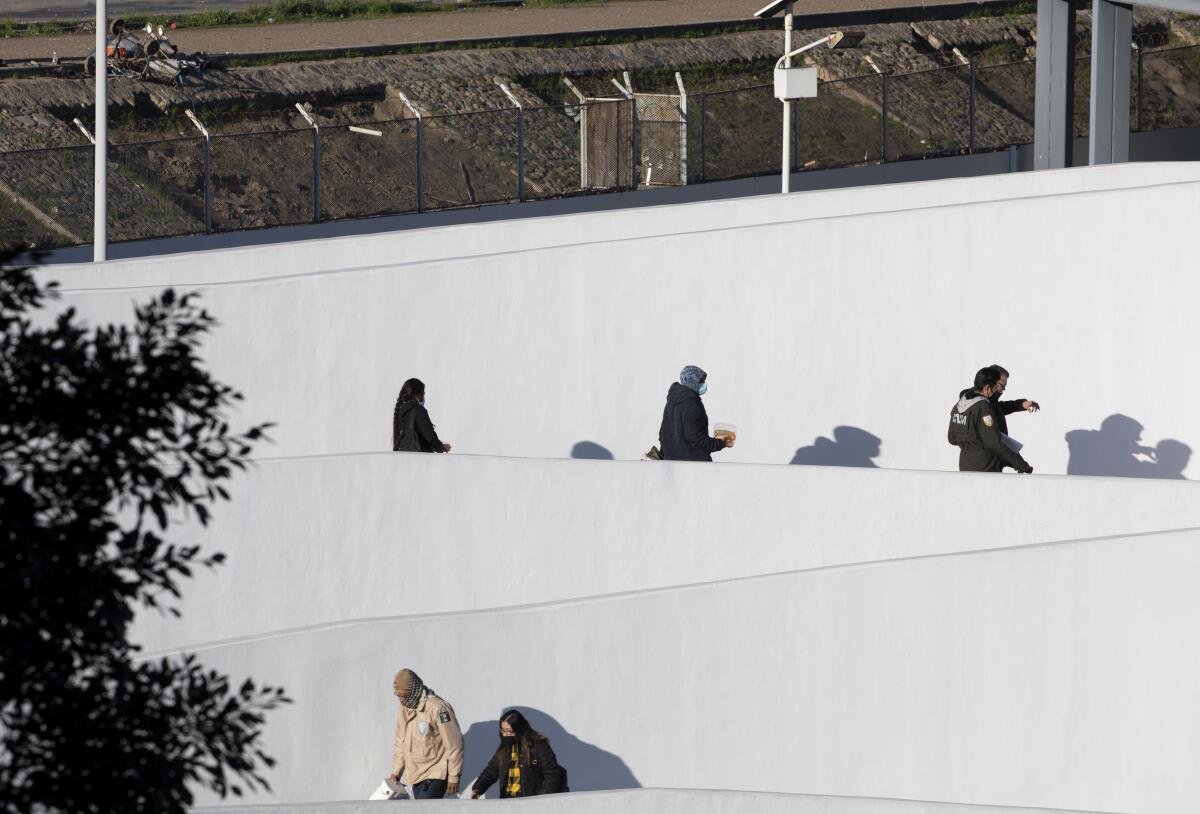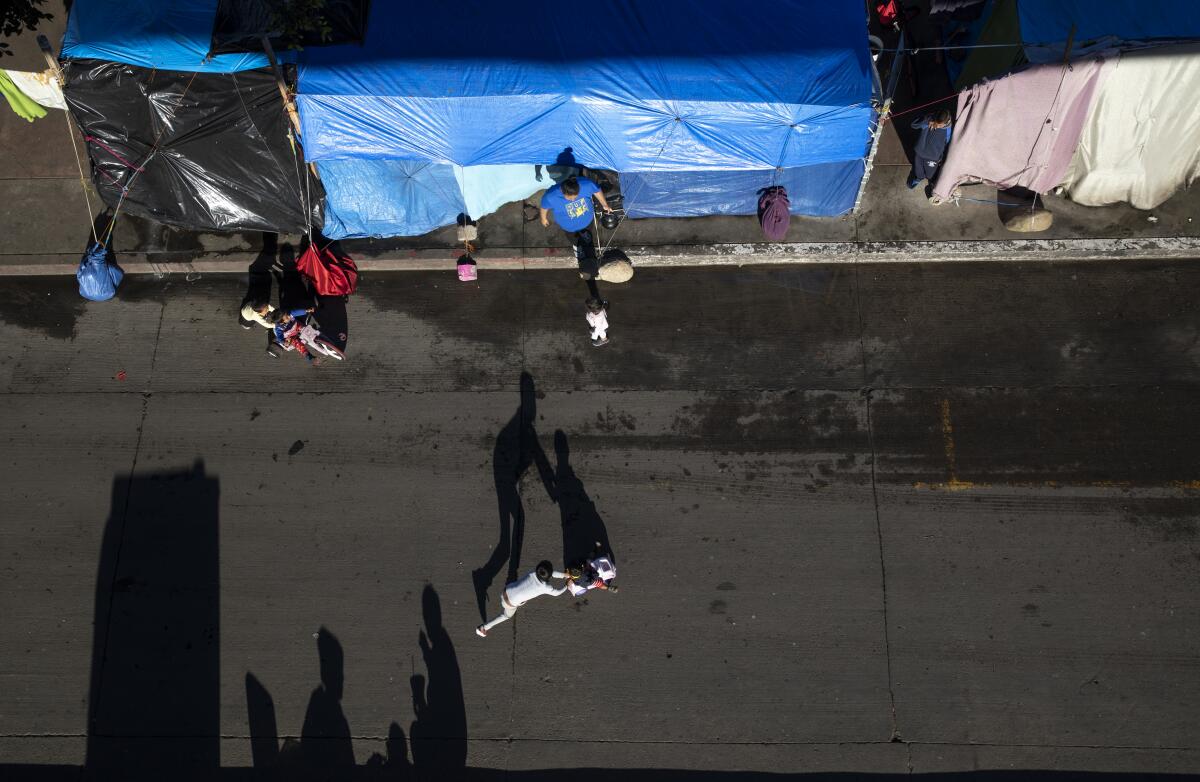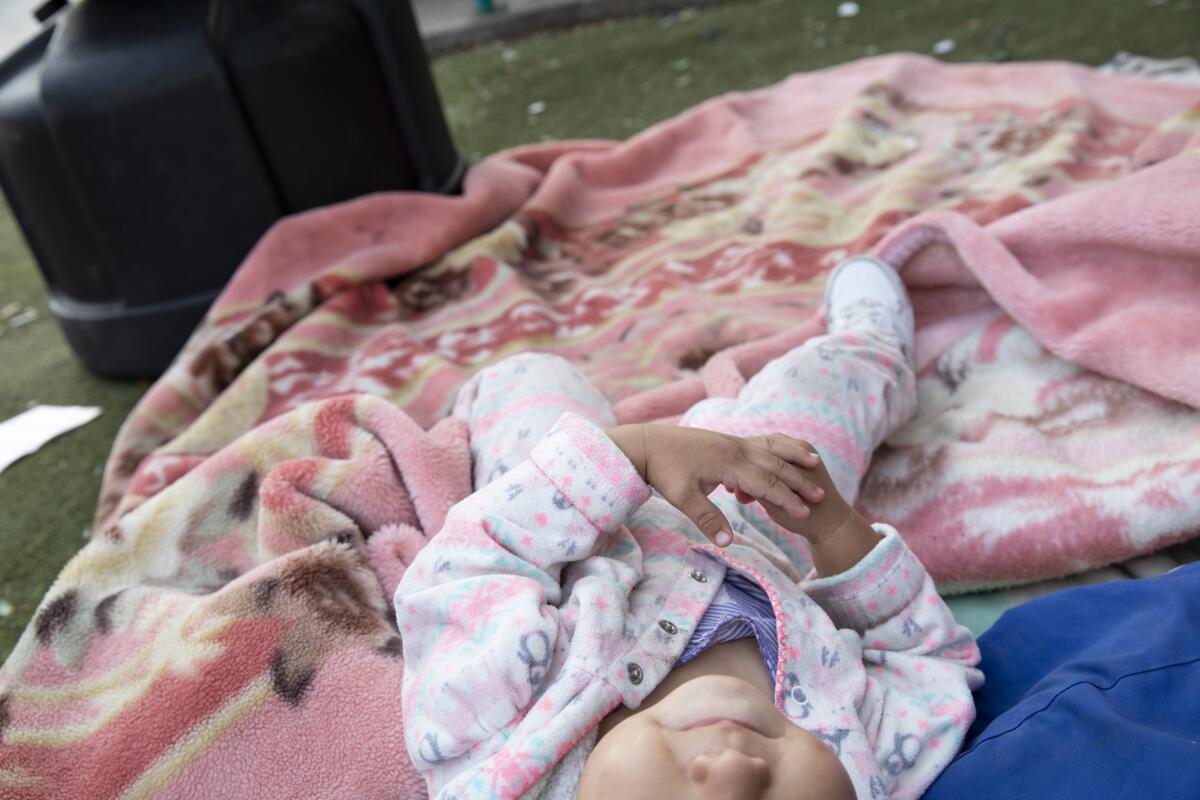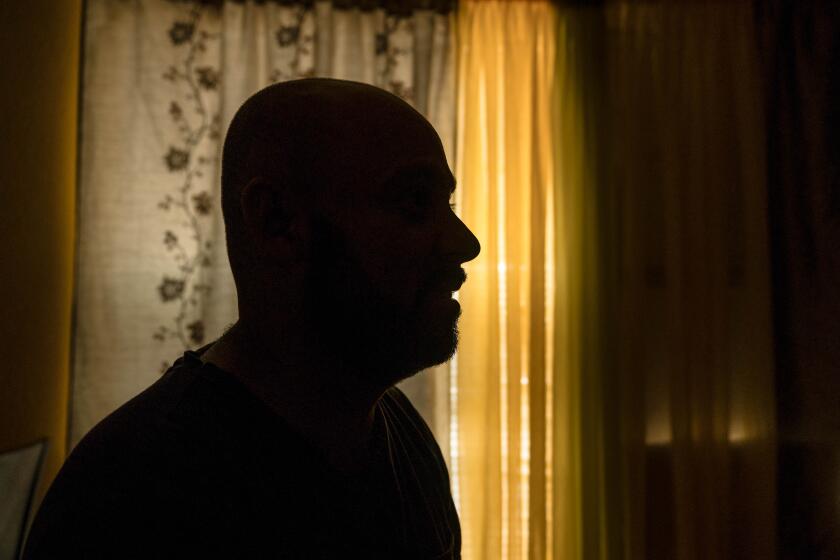‘Remain in Mexico’ program returns to San Diego-Tijuana border

- Share via
SAN DIEGO — San Diego on Monday became the second U.S. border city where federal officials restarted the “Remain in Mexico” program.
No asylum seekers were immediately returned to Tijuana to wait for their U.S. immigration court hearings, according to senior officials with the Biden administration speaking on background. The first returns from San Diego to Mexican soil are likely to happen Tuesday or Wednesday.
The program, first implemented by the Trump administration in 2019 with the intention of deterring asylum seekers by keeping them out of the United States while their claims were processed, was halted after President Biden took office. A federal judge ordered the program, known officially as Migrant Protection Protocols, or MPP, to be reimplemented after Texas and Missouri sued over the way the policy ended. The Biden administration has since used that ordered restart to expand the program to additional nationalities, including Haitians.
San Diego Border Patrol agents were officially able to enroll people apprehended crossing into the United States into the program beginning Monday. The first returns will come later because asylum seekers who say they are afraid to go back to Mexico have up to 24 hours to consult with attorneys prior to screening interviews, where they must prove their fear is based on a “reasonable possibility” of harm by being removed from the program.
The Biden administration has defended the restart as something it was forced to do. The president criticized the program on the campaign trail and has continued to appeal the ordered restart up to the Supreme Court.
“We are under this injunction to comply in good faith with the court order,” said an administration official speaking on background during a press call Monday. “As we do so, we are very committed to ensuring that we do so in ways that address to the greatest degree possible the humanitarian concerns that were raised by the prior implementation.”
But asylum advocates have questioned that characterization because of the expansion.
The reimplementation began in El Paso, Texas in December. On Monday, 36 returnees crossed into the United States, some as early as 4:30 a.m., to attend the first immigration court hearings of the reboot, officials said.
As of Monday, U.S. officials had returned 213 people to Ciudad Juárez, according to the U.N. migration agency, which tests returnees for COVID-19 and offers transportation to shelters designated by Mexican border officials.
Nicaraguans have been the largest group returned under the beginning of the reboot, according to data obtained in December by Human Rights First researcher Julia Neusner. Asylum seekers from Venezuela, Colombia, Cuba and Ecuador have also been sent back under MPP.

The program as run by the Trump administration was slammed by critics over a number of issues. Among the most concerning was that it put asylum seekers in danger in northern Mexico border towns where they were forced to wait. Human Rights First documented more than 1,500 violent attacks on asylum seekers in the program — assaults, kidnappings, rapes and even murders — during the program’s initial two-year existence.
Most asylum seekers in Mexico were unable to find attorneys to represent them or even adequate housing for the often extended periods they were required to wait, and scheduling snafus and inaccurate documentation by border officials plagued the program.
Mexico said it pushed the United States during restart negotiations to address some of these concerns and that in agreeing to receive people placed into MPP, it felt the United States had addressed them. Those measures include U.S. funding for Mexican migrant shelters and for transportation of asylum seekers in the program between ports of entry and shelters.
Gangs have infiltrated remote municipalities, intimidated voters, murdered opposing candidates and seized control of local town halls.
When asked about how much money the United States is spending on those efforts, the Department of Homeland Security deferred to the Department of State. The Department of State did not respond to questions about that funding.
Many details about the program’s logistics remain unclear.
Human Rights First has already reported evidence of border officials not following required steps in determining eligibility for the program. Some of the first asylum seekers returned to Ciudad Juárez told Neusner they weren’t asked the specific questions on a medical screening form found among the documents given to them before their return. Officials had checked “no” on all of the boxes on the form, meaning that those asylum seekers would not be exempted from the program for medical reasons.
The organization also reported that every person returned under the program interviewed by its researchers had experienced harm in Mexico, including kidnappings or violence at the hands of police or other officials prior to being selected for MPP.
When asked about this issue in a press call on Monday, administration officials said that asylum seekers in the program can go to ports of entry or reach out to U.S. officials via email if they feel they’ve been incorrectly placed into the program or if their situations have changed.

Human rights organizations and legal services organizations that support asylum seekers in Mexico have come out strongly against the program. The union representing asylum officers, who are responsible for conducting interviews to determine whether someone is ineligible for the program because of specific harms that likely await them in Mexico, has also condemned the reboot, calling the program “irredeemably flawed.”
“Its implementation makes our members complicit in violations of U.S. federal law and binding international treaty obligations of non-refoulement that they have sworn to uphold,” the union said. “While the administration has taken measures intended to mitigate some of the most egregious elements of MPP’s prior iteration, a program that requires asylum seekers to remain in one of the most dangerous parts of the world while their cases are pending in U.S. immigration courts cannot guarantee their protection from persecution and torture, as required by U.S. law.”
Meanwhile, many asylum seekers in a tent camp near the San Ysidro Port of Entry have been asking how to get enrolled into the program.
As the border region experiences a cold and rainy winter, those living in the camp are struggling to stay warm and dry. During the heaviest days of rain, their tents flooded. For them, the possibility of having a chance at presenting evidence in their cases is an improvement over their current situations, even if it means they have to wait longer in Mexico.
That’s because asylum processing in general has been closed to most since the pandemic began, leading to many being indefinitely stuck along the border. The Trump administration used a public health order from the Centers for Disease Control and Prevention to tell border officials to expel migrants caught crossing without documents back to Mexico or to their home countries. The Biden administration has continued that policy, known as Title 42.
Nationality will end up playing a key role in how the two programs interact.
So far, the Biden administration seems to be returning nationalities under MPP that it hasn’t been subjecting to Title 42. Officials on Monday’s call confirmed that migrants are first evaluated for potential expulsions under Title 42 before being processed for Remain in Mexico.
In November, roughly 24% of single adults and family members apprehended by San Diego Border Patrol were nationalities that are eligible for MPP, according to the most recent data available from Customs and Border Protection.
That includes 1,480 Brazilians, 385 Nicaraguans and 265 Venezuelans, the largest three groups eligible for the program. Only one person among them was expelled.
About 12% of those apprehended in November who might be eligible for MPP were Salvadorans, Guatemalans or Hondurans, but they were generally expelled under Title 42.
About 94% of Mexicans, by far the largest group of border crossers, were also expelled. Mexicans are not eligible for MPP.

That fact disappointed a family of women and children, including a baby, from Michoacán who slept under a jungle gym on a small playground near the tent camp. The family asked Mexican officials to take its members to a shelter, but they were still at the playground after days of waiting in the cold for a phone call that someone had space to receive them. The city has fenced off the area around the camp and is not allowing new arrivals to enter.
The rollout of the new version of the Remain in Mexico program will continue in five other locations — Calexico, Calif.; Nogales, Ariz.; and Eagle Pass, Laredo and Brownsville in Texas.
More to Read
Sign up for Essential California
The most important California stories and recommendations in your inbox every morning.
You may occasionally receive promotional content from the Los Angeles Times.













